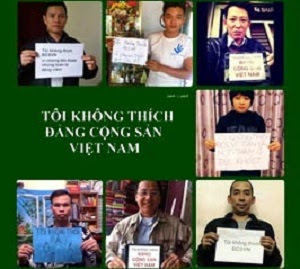Nhật Nam
Jan-10-2015
Bên lề Hội nghị Ban chấp hành Trung ương lần thứ 10 Khóa 11 của đảng cộng sản Việt Nam,một số nhà hoạt động tại Việt Nam đã hưởng ứng phong trào “Tôi không thích đảng cộng sản Việt Nam”.
Họ in hoặc viết câu khẩu hiệu “Tôi không thích ĐCSVN” lên giấy, rồi cầm tấm khẩu hiệu đó khi chụp hình và đăng tải trên trang mạng xã hội Facebook. Họ viết thêm những lý do vì sao không thích ĐCSVN như: “nói một đằng làm một nẻo”, “vì trong đảng đó toàn là sâu, chuột”, “vì những kẻ tham nhũng đều là đảng viên” …
Trong giai đoạn 2010 đến nay, nền kinh tế Việt Nam liên tiếp gặp những khó khăn, suy thoái, không chỉ do tác động của kinh tế thế giới, mà còn do sự điều hành kém của CSVN. Tình hình đạo đức xã hội xuống cấp, tội phạm gia tăng, nạn tham nhũng ngày càng tệ hại. Bên cạnh đó là sự yếu hèn của CSVN trước Trung Cộng và những đòn trấn áp với giới đấu tranh trong nước. Tất cả những điều trên đã khiến người dân trong nước “không thích ĐCSVN”.
Phong trào này không rõ do ai khởi xướng, cũng không có lời kêu gọi, phát động. Nó diễn ra ngay đúng ngày khai mạc Hội nghị lần thứ 10 Khóa 11 của đảng cộng sản Việt Nam. Nó mang nhiều ý nghĩa, thể hiện rõ nét suy nghĩ, tình cảm và lòng tin của người dân đối với Đảng CSVN ngày càng trở nên tồi tệ. Hội nghị Ban chấp hành trung ương ĐCSVN lần này kéo dài 7 ngày, từ ngày 5 đến 12/1/2015. Hội nghị này sẽ tập trung bàn thảo các vấn đề liên quan đến cơ cấu nhân sự cho Đại hội toàn quốc ĐCSVN lần thứ 12 sẽ diễn ra vào giữa năm 2015, kiện toàn các dự thảo văn kiện cho Đại hội Đảng CSVN – chủ yếu là 2 văn kiện báo cáo chính trị và kinh tế – xã hội và một số vấn đề nội bộ khác.
Đây cũng là lần đầu tiên Đảng CSVN tổ chức lấy phiếu tín nhiệm đối với các ủy viên Bộ Chính trị và Ban bí thư của ĐCSVN. Trước kỳ hội nghị này, các quan chức cấp cao như Trần Đại Quang – Bộ trưởng Công an, Phùng Quang Thanh – Bộ trưởng Quốc Phòng, Vũ Đức Đam – Phó thủ tướng và một số nhân vật khác đã chỉ đạo “siết chặt quản lý việc truy cập, khai thác thông tin trên internet, ngăn chặn những thông tin xấu, xuyên tạc, bôi nhọ, gây chia rẽ trong nội bộ ĐCSVN” trước thềm hội nghị này và đại hội toàn quốc ĐCSVN sắp tới.
Tại Đại hội Thanh niên toàn quốc mới diễn ra tại Hà Nội, ông Nguyễn Phú Trọng có phát biểu 1 bài dài, trong đó có câu: “Thanh niên có “tâm” là phải yêu chế độ”. Một câu phát biểu bị cho là đánh tráo khái niệm, khiến nhiều người chỉ trích. Đa số người dân yêu nước thương nòi, nhưng đã quá ngán chế độ toàn trị và chính quyền tham nhũng của CSVN. Chắc hẳn ông Trọng và các “đồng chí” của ông sẽ không vui khi thấy người dân, đặc biệt là những người trẻ tuổi cầm khẩu hiểu “Tôi không thích ĐCSVN”.
Thật đáng khâm phục những con người dũng cảm trong nước, dám công khai nói lên suy nghĩ của mình về chế độ CSVN, đặc biệt trong giai đoạn CSVN trấn áp mạnh tay những người bất đồng chính kiến như hiện nay.
















_in_the_Atlantic_Ocean_April_2007.jpg)

_2010-01-27.jpg)


















